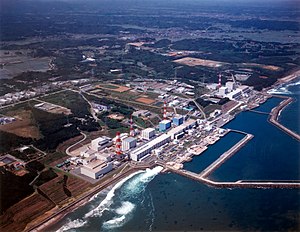
Back Fukushima-Daiichi-kernaanleg Afrikaans Kernkraftwerk Fukushima I ALS محطة فوكوشيما النووية الأولى لتوليد الطاقة Arabic Fukuşima-1 AES Azerbaijani АЭС Фукусіма I BE-X-OLD АЕЦ „Фукушима I“ Bulgarian ফুকুশিমা দাইইচি পরমাণু বিদ্যুৎ কেন্দ্র Bengali/Bangla Central nuclear de Fukushima Dai-ichi Catalan Jaderná elektrárna Fukušima I Czech Фукусима-1 CV
| Fukushima Daiichi Nuclear Power Plant | |
|---|---|
 Aerial photo from 2007 | |
 | |
| Country | Japan |
| Location | Ōkuma, Fukushima |
| Coordinates | 37°25′23″N 141°01′59″E / 37.42306°N 141.03306°E |
| Status | Being decommissioned |
| Construction began | July 25, 1967 |
| Commission date | March 26, 1971 |
| Decommission date |
|
| Owner(s) | |
| Operator(s) | Tokyo Electric Power Company |
| Nuclear power station | |
| Reactor type | BWR |
| Reactor supplier | General Electric Toshiba Hitachi |
| Power generation | |
| Units cancelled | 2 × 1,380 MW |
| Units decommissioned | 1 × 460 MW (Unit 1) 4 × 784 MW (Units 2, 3, 4 and 5) 1 × 1,100 MW (unit 6) |
| Nameplate capacity | 5,306 MW (1979–2011) |
| External links | |
| Website | www |
| Commons | Related media on Commons |
The Fukushima Daiichi Nuclear Power Plant (福島第一原子力発電所, Fukushima Daiichi Genshiryoku Hatsudensho, Fukushima number 1 nuclear power plant) is a disabled nuclear power plant located on a 3.5-square-kilometre (860-acre) site[1] in the towns of Ōkuma and Futaba in Fukushima Prefecture, Japan. The plant suffered major damage from the magnitude 9.1 earthquake and tsunami that hit Japan on March 11, 2011. The chain of events caused radiation leaks and permanently damaged several of its reactors, making them impossible to restart. The working reactors were not restarted after the events.
First commissioned in 1971, the plant consists of six boiling water reactors. These light water reactors[2] drove electrical generators with a combined power of 4.7 GWe, making Fukushima Daiichi one of the 15 largest nuclear power stations in the world. Fukushima was the first nuclear plant to be designed, constructed, and run in conjunction with General Electric and Tokyo Electric Power Company (TEPCO).[3] The sister nuclear plant Fukushima Daini ("number two"), 12 km (7.5 mi) to the south, is also run by TEPCO. It also suffered serious damage during the tsunami, at the seawater intakes of all four units, but was successfully shut down and brought to a safe state. See the timeline of the Fukushima II nuclear accidents.[4]
The March 2011 disaster disabled the reactor cooling systems, leading to releases of radioactivity and triggering a 30 km (19 mi) evacuation zone surrounding the plant; the releases continue to this day. On April 20, 2011, the Japanese authorities declared the 20 km (12 mi) evacuation zone a no-go area which may only be entered under government supervision. In November 2011, the first journalists were allowed to visit the plant. They described a scene of devastation in which three of the reactor buildings were destroyed; the grounds were covered with mangled trucks, crumpled water tanks and other debris left by the tsunami; and radioactive levels were so high that visitors were only allowed to stay for a few hours.[5]
In April 2012, Units 1–4 were shut down. Units 2–4 were shut down on April 19, while Unit 1 was the last of these four units to be shut down on April 20 at midnight.[citation needed] In December 2013 TEPCO decided none of the undamaged units will reopen. In April 2021, the Japanese government approved the discharge of radioactive water, which has been treated to remove radionuclides other than tritium, into the Pacific Ocean over the course of 30 years.[6]
- ^ "Tepco site (Japanese). One Week Plant Grounds Course. 福島第一原子力発電所 | PR施設:構内見学コース". April 7, 2011. Archived from the original on April 7, 2011. Retrieved October 27, 2016.
350万平方メートルの広い敷地に = 3.5 km2
- ^ "Tokyo Electric Power Co. Fukushima Daiichi Nuclear Power Station". jnes.go.jp. Archived from the original on March 14, 2011. Retrieved March 17, 2011.
- ^ "The Asahi Shimbun". Archived from the original on April 7, 2011. Retrieved February 7, 2017.
- ^ The Fukushima Daiichi Accident (PDF). Wienna: IAEA – International Atomic Energy Agency. 2015. pp. 131–132. ISBN 978-92-0-107015-9. Retrieved October 12, 2018.
- ^ Fackler, Martin (November 12, 2011). "Eyewitness Report: Inside the Wreckage of Japan's Fukushima Nuclear Plant". The Daily Telegraph. Retrieved July 27, 2019.
- ^ Cite error: The named reference
AP 20210413was invoked but never defined (see the help page).